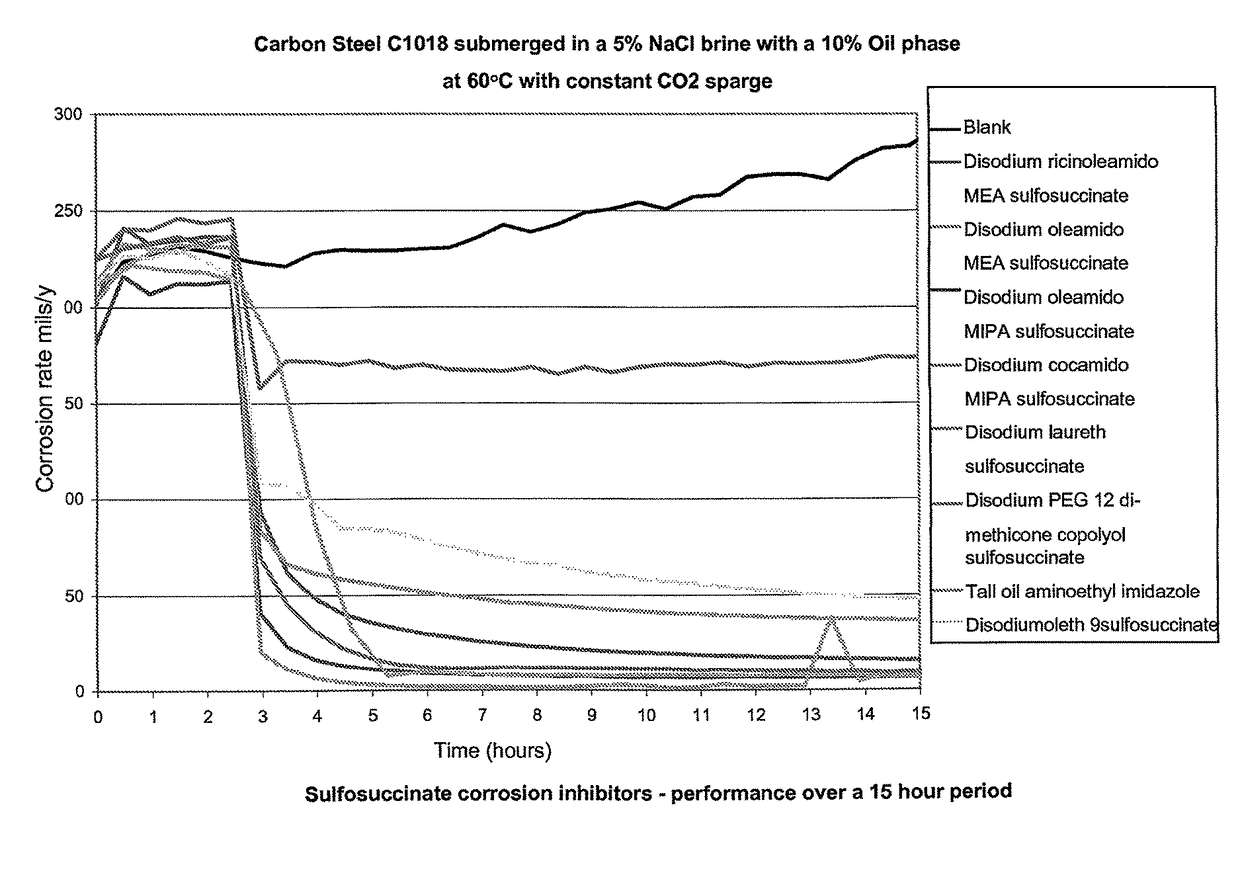Corrosion inhibitors
a corrosion inhibitor and corrosion technology, applied in the field of surfactants, can solve the problems of poor aquatic toxicity, corrosion of steel and other metal surfaces in the presence of aqueous environments, and poor corrosion resistance of various conduits and other components in the production zon
- Summary
- Abstract
- Description
- Claims
- Application Information
AI Technical Summary
Benefits of technology
Problems solved by technology
Method used
Image
Examples
example 1
Linear Polarisation Resistance (LPR) Test
[0187]A modified version of the bubble test was used to compare the corrosion inhibition performance of various sulfosuccinates to the industry standard corrosion inhibitor, tall oil aminoethyl imidazole, under oilfield conditions.
[0188]The sulfosuccinates tested were:[0189]Disodium ricinoleamido MEA sulfosuccinate[0190]Disodium oleamido MEA sulfosuccinate[0191]Disodium oleamido MIPA sulfosuccinate[0192]Disodium cocamido MIPA sulfosuccinate[0193]Disodium laureth sulfosuccinate[0194]Disodium PEG 12 dimethicone sulfosuccinate[0195]Disodium oleth 9 sulfosuccinate
Method[0196]Each cell was charged with the desired weight of brine and oil.[0197]Every cell had a stirring bar, auxiliary electrode, reference electrode, gas sparge tube, and glass periscope inserted.[0198]The cells were placed in a water bath set at 60° C. and set to stir at approximately 300 rpm.[0199]Each cell was connected to a constant sparge of CO2 and then left for 1 hour to reach...
example 2
Static acid Immersion Tests
[0217]Static acid immersion tests were used to compare the corrosion inhibition performance of various sulfosuccinates in 5% w / w HCl to the industry standard propargyl alcohol (2-propyn-1-ol) and the corrosion inhibitor Stannine® ETH, which is a blend of amine salts and aliphatic alcohols and is available from Rhodia Novecare.
Method
[0218]A control solution of 5% w / w HCl was prepared by diluting 37% w / w HCl with deionised water.[0219]An inhibited solution of 5% w / w HCl & 2000 ppm w / w active corrosion inhibitor was then prepared for each of the corrosion inhibitors being evaluated. Stannine® ETH was used at 2000 ppm w / w solids as the active content of Stannine® ETH is unknown.[0220]Each solution was then split evenly between 2 Schott bottles (for duplicate runs) and a pre-weighed C1018 mild steel coupon was placed in each so that it was completely submerged.[0221]The Schott bottles were then sealed tightly and stored for 24 hours in an oven set at 50° C.[022...
example 3
Linear Polarisation Resistance (LPR) Bubble Test
The same tests as described in Example 1 were carried out on the products set out in Table 3 below.
[0227]
TABLE 3ProductChemical nameActivity %PolySugaMate L (fromDisodium sulfosuccinate lauryl38Colonial Chemicals)glucoside(as solid)crosspolymer (dp~4)Rhodoline HP half esterTerpene (C9) block alkoxylated35sulfosuccinate (from(EO) (PO) half ester sulfosuccinateRhodia Novecare)where the terpene alkoxylate hasan HLB in the range of from3 to 5.Mackterra TDITall oil aminoethyl imidazoline100
Results and Discussion
The results are shown in FIGS. 4 and 5 (corrosion rate) and FIG. 6 (corrosion efficiency).
In FIG. 4 it can be seen that, under oilfield conditions, all of the sulfosuccinates tested reduce the observed corrosion rates.
[0228]FIG. 5 provides a direct comparison between the terpene block alkoxylated half ester sulfosuccinate and the industry standard (tall oil aminoethyl imidazoline). It can be seen that, over time, the anti-corrosion ...
PUM
| Property | Measurement | Unit |
|---|---|---|
| molecular weight | aaaaa | aaaaa |
| molecular weight | aaaaa | aaaaa |
| molecular weight | aaaaa | aaaaa |
Abstract
Description
Claims
Application Information
 Login to View More
Login to View More - R&D
- Intellectual Property
- Life Sciences
- Materials
- Tech Scout
- Unparalleled Data Quality
- Higher Quality Content
- 60% Fewer Hallucinations
Browse by: Latest US Patents, China's latest patents, Technical Efficacy Thesaurus, Application Domain, Technology Topic, Popular Technical Reports.
© 2025 PatSnap. All rights reserved.Legal|Privacy policy|Modern Slavery Act Transparency Statement|Sitemap|About US| Contact US: help@patsnap.com



